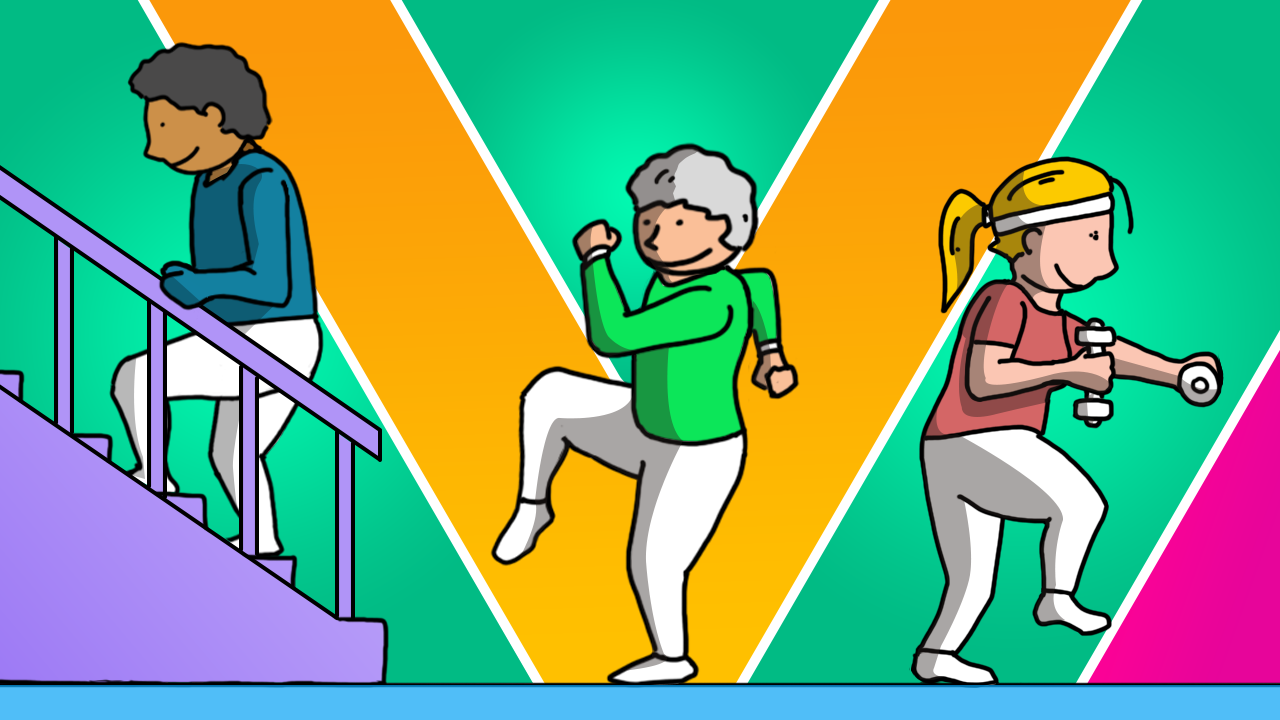Lockdown muscle loss: Five ways to get back in shape
- Published

Millions of people missed out on regular exercise and are likely to have lost muscle mass during the Covid-19 pandemic, say experts.
Nearly a third of people believed their general strength had declined, according to a survey for the Chartered Society of Physiotherapy and Sport England. Almost a quarter (23%) of under-34s said it had dipped, either "a bit" or "a lot", while the figure was higher for those aged over 55.
Muscle loss can lead to long-term problems with mobility and balance. Those in turn can trigger or aggravate a whole range of serious health conditions. Experts say that that those with persistent problems should seek help from a doctor or physiotherapist, but there are things that many people can do to get themselves back in shape.
Start small
Getting started with some basic exercise is the hardest thing for many people, say the experts. Their advice: don't try to do too much.
"Starting small is the key to motivation," says Uzo Ehiogu of the Royal Orthopaedic Hospital in Birmingham. "You need one small win everyday."
Strengthening exercise is fundamentally about moving heavy things. But that doesn't necessarily mean big weights. Your own bodyweight can be enough. For someone who has been doing very little or no exercise during lockdown, 15 minutes of housework or gardening, or an extra thousand steps a day, could be a good place to start, he says.
"The single biggest factor in forming healthy habits is consistency." So the best way to achieve that is to set small goals which you know you can achieve. "People with grandiose goals are much less likely to stick with them."
Starting with a few push ups or half push ups, sit to stand exercises or squats and lunges - can go a long way.
Push and pull
Our upper body muscles, the biceps, triceps, pectoral or chest muscles, and trapezius muscle in back and shoulders may well have weakened during the lockdown. Lisa Osborn-Jenkins, who treats patients in Southampton, says simple things like changing the way we shop may have added to the problems.
"Carrying loaded shopping bags is a great strength activity. The switch to online shopping means that's gone for many people."
A good way to get it back is to start doing push and pull exercises.
"The muscles in the front of your body are usually good at pushing, and the muscles in the back are good at pulling," says Mr Ehiogu. "You should try to balance them both."
So that can mean press-ups, or three-quarter press-ups on your knees if full press-ups are too much, with initially just a few repetitions. A pull exercise can be a rowing action, using a stretch band, or a pull-up using a cheap pull-up bar on a door frame.
And it doesn't need to be formal exercise. Moving things around in the garden or cleaning out a cupboard can give you the same workout.
Leg work
Simple exercises for your lower body and your core can yield big benefits, says neurological specialist Dr Caroline Appel. That means exercising the leg muscles, your bottom, abdominals and lower back.
"Sit to stand exercises are good way to start," she says, along with calf raises and stepping up and down the stairs. Just start with 10 repetitions and build up, "Build up more slowly than you think you can," says Dr Appel.
When you're ready, and if it's appropriate, you can move on to squats and lunges.
"If you don't have a lot of money for equipment, it shouldn't stop you. You can start with almost nothing."
Schedule it
Having a schedule written down helps us to overcome "decision fatigue" and stay on track says physiotherapist Ben Lombard.
He points out millions of people have been missing out on incidental exercise such as walking to the station during lockdown. So making a schedule to make up for lost exercise has become doubly important.
"People need to be organised with simple, smart and specific goals," says Patricia Smith of the University of London. That's hard to achieve without a schedule.
Ms Smith says that exercising at the same time each day can also help us to develop healthy routines. And Lisa Osborn-Jenkins says it's doubly effective if you can make it social. Exercising with others gives you two sorts of motivation: "There's the enjoyment from being with others, and there's the all important feeling that you won't want to let them down by not turning up."
Leave your kit out
Leaving your exercise kit laid out the night before is a good way to make sure you don't back out of exercising in the morning, says Mr Lombard.
"It's about minimising the mental barriers to exercise."
In those few minutes, perhaps when you've just woken up, seeing your kit laid out and ready, is a powerful signal that a firm decision has been made. You're doing it.
Having to hunt through your wardrobe for your shorts makes it much more likely that you'll back out - and next time roll over and go back to sleep.
Likewise, Mr Ehiogu says: "Put your trainers by the door."
If you've got out of the habit of exercise during lockdown, give yourself one less reason to avoid getting back into it now.
Illustrations by Gerry Fletcher